Second Prophet of Amun
The Second Prophet of Amun (hm netjer sen-nu en Amun), also called the Second Priest of Amun, was a high ranking priestly official in the cult of the ancient Egyptian god Amun. The Second Prophet of Amun office was created in the New Kingdom, at the beginning of the Eighteenth Dynasty.
History
New Kingdom
The office of second prophet of Amun was created in the beginning of the 18th dynasty during the reign of Ahmose I. A donation stela from Karnak records how king Ahmose purchased the office of Second Prophet of Amun and endowed the position with land, goods and administrators. The position of Second Prophet of Amun was put under the authority of the God's Wife of Amun at its creation.[1]
- Made in the presence of the [...officials...] of the territory of Thebes and the temple priesthood of Amun. What was said m hm n stp-si l.p.h. on this day, [saying]: "The office of Second Priest of Amun [shall] belong to the God's Wife, Great Royal Wife, united with the white crown, Ahmose-Nefertari, living; having been made for her in an imyt-pr, from son to son, heir to heir, [without allowing] it [to be interfered by anybody forever and ever [2]
The endowment was given to Ahmose-Nefertari and her descendants.[3] The record was signed and later confirmed by an oracle.[2] Records from a later era indicate that in this position she would have been responsible for all temple properties, administration of estates, workshops, treasuries and all the associated administration staff.[4]
During the reign of Hatshepsut and Tuthmosis III the Second Prophet was involved in royal constructions at Karnak. The Second Prophet Puimre oversaw the erection of an ebony shrine dedicated to Hatshepsut,the construction of two obelisks for Tuthmosis II and the construction of doors made of Tura limestone. In Puimre's tomb it is shown that he additionally was in charge of receiving goods from oases and tribute from Nubia, including captives.[5]
Third Intermediate Period
Under the High Priests of Amun Piankh and Pinedjem I in the Twenty-first Dynasty of Egypt the position of Second Prophet was taken up by relatives of the High Priests. From the time of Menkheperre on the positions of 2nd, 3rd and 4th Prophet of Amun were not taken up by the family of the High Priest of Amun. The positions were given to local Theban nobles, who would often marry into the family of the High Priest.[6]
During the Twenty-fifth Dynasty of Egypt the Nubian rulers broke the hold of the local families on these priestly positions. Shabaqo appointed Kelbasken as 4th prophet and later his son Haremakhet as High Priest of Amun. Taharqa appointed his son Nesishutefnut as Second Prophet of Amun.[7]
Notable Second Prophets of Amun
| Name | Image | Time Period | Comment | ||||||
|---|---|---|---|---|---|---|---|---|---|
| Ahmose-Nefertari | 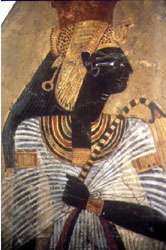 | 18th Dynasty | Wife of Ahmose I and mother of Amenhotep I | ||||||
| Puimre [5] | 18th dynasty | son-in-law of HPA Hapuseneb | |||||||
| Ahmose | 18th dynasty | Buried in Theban Tomb 121. He may have served in Deir el-Bahari instead of at Karnak. | |||||||
| Menkheperreseneb II | 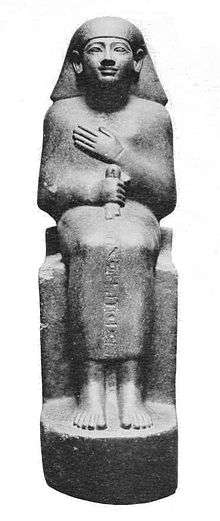 | 18th dynasty | Known from a statue in the British Museum. From the reigns of Hatshepsut and Tuthmosis III. | ||||||
| Neferhotep [5] | 18th dynasty | Son of Vizier Rekhmire. He may have served in Deir el-Bahari instead of at Karnak. | |||||||
| Merymaat [5] | 18th dynasty | Grandson of Vizier Amethu called Ahmose, likely reign of Tuthmosis III. | |||||||
| Mahu | 18th dynasty | Mahu is shown in the tomb of Pehsukher called Thenenu - TT 88 - in Thebes.[5] Pehsukher's life and career spanned the reigns of Thutmosis III and Amenhotep II. | |||||||
| Amunhotep Sise | 18th dynasty | Reign of Thutmose IV, buried in TT 75 | |||||||
| Nefer | 18th dynasty | reign of Amunhotep II - Amunhotep III | |||||||
| Anen | 18th dynasty | Brother of Queen Tiye.[1] Buried in TT120 in Thebes. | |||||||
| Simut | 18th dynasty | Successor of Anen; end of the reign of Amenhotep III.[1] | |||||||
| Ay (Yii) | 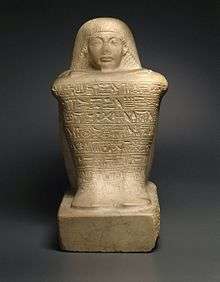 | 18th dynasty | Known from a statue in Brooklyn Museum, time of Tutankhamun and Ay[8] | ||||||
| Roma called Roy | 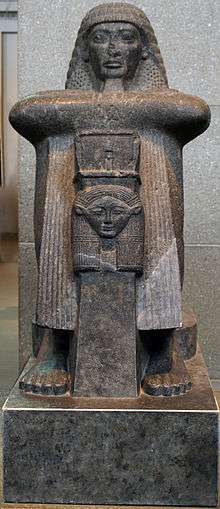 | 19th dynasty | Served as Second prophet before becoming high priest. Served during the reign of Ramesses II. | ||||||
| Bakenkhons I | 19th dynasty | Son of Roma-Roy | |||||||
| Hornakht | 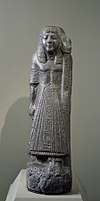 | 20th dynasty | Buried in TT236 | ||||||
| Nesamun | 20th dynasty; Renaissance era; ca 1074 BC [6] | son of Ramessesnakht, High Priest of Amun and brother of Amenhotep, High Priest of Amun. | |||||||
| Heqanefer [9] | 21st dynasty; ca 1070 BC [6] | Son of High Priest of Amun Piankh and brother of the High Priest of Amun Pinedjem I | |||||||
| Amunhirpamesha? | 21st dynasty; ca 1040 BC [6] | May be a Second Prophet of Amun from the reign of Smendes I? [6] | |||||||
| Smendes II |  | 21st dynasty | Son of the HPA Menkheperre was Second Prophet of Amun before he became HPA according to the El-Hibeh archive.[10] | ||||||
| Tjanefer (A) | 21 st dynasty; ca 975 BC | Son-in-law of HP Menkheperre. Served mainly as Third Prophet of Amun, but may have once been attested as Second Prophet of Amun. Tjanefer was buried in TT 158.[10] | |||||||
| Djed-ptah-ef-ankh (A) |  | 22nd dynasty; ca 945-935 BC | Known from his burial in the royal cache DB320. He is listed as King's Son of Ramesses indicating that he may be related to the royal family of the 21st dynasty. He likely died during the reign of Shoshenq I.[10] | ||||||
| Bakenamun | 22nd dynasty | Known from inscriptions from a chapel of Thoth and Amun at Karnak. Dated to the time of either Osorkon I or Osorkon II.[10] | |||||||
| Pashereniset (Pa-Khered-(en)-Iset) | Known from shabtis and canopics jars (now in Cairo), originally found at Tehneh.[10] | ||||||||
| Harsiese (C) | 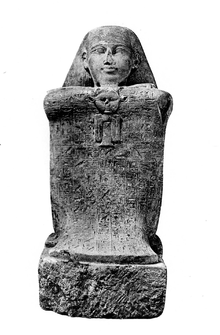 | 23rd dynasty; ca 855 BC [6] | son of Nakhtefmut [10] | ||||||
| Djed-ptah-ef-ankh (D) | 23rd dynasty ca 835 BC [6] | son of Takelot III [10] | |||||||
| Nes-hor-bedjet | 23rd dynasty; ca 740 BC[6] | Reign of Takelot III | |||||||
| Djed-khons-ef-ankh (C) | 23rd dynasty | Son of Harsiese (C). Possibly 2PA - according to Bierbrier.[10] | |||||||
| Patjenfy | 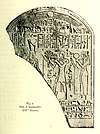 | dynasty 25; ca720-700 BC | Reign of Shabaqo | ||||||
| Nesi-shu-tefnut | dynasty 25; ca 680 BC | Son of Taharqa [7] | |||||||
| Neshorbedjet | 26th Dynasty; ca 650-640 BC | ||||||||
References
- O'Connor, David and Cline, Eric H. Amenhotep III: Perspectives on His Reign, University of Michigan Press. 2001, pp 209-210 ISBN 978-0472088331
- Gary J. Shaw, The meaning of the phrase M ḤM N STP-Sⳍ, The Journal of Egyptian Archaeology, Vol. 96 (2010), pp. 175-190, Egypt Exploration Society, Stable URL: https://www.jstor.org/stable/23269763
- Tyldesley, Joyce. Chronicle of the Queens of Egypt. Thames & Hudson. 2006. ISBN 0-500-05145-3
- "The Great Goddesses of Egypt', Barbara S. Lesko, p. 246, University of Oklahoma Press, 1999, ISBN 0-8061-3202-7
- Eric H. Cline, David B. O'Connor, Thutmose III: A New Biography, University of Michigan Press, 2006
- Kitchen, Kenneth A. The Third Intermediate Period in Egypt, 1100-650 B.C. (Book & Supplement) Aris & Phillips. 1986 ISBN 978-0856682988
- Morkot, Robert G., The Black Pharaohs: Egypt's Nubian Rulers, The Rubicon Press, 2000, pp 236-237 ISBN 0-948695-24-2
- Block Statue of Ay. Brooklyn Museum
- Peter Keegan, Graffiti in Antiquity, Routledge, Oct 10, 2014
- Gerard P.F. Broekman,The leading Theban Priests of Amun and their families under Libyan Rule, The Journal of Egyptian Archaeology, Vol. 96 (2010), pp. 125-148, Egypt Exploration Society, Stable URL: https://www.jstor.org/stable/23269760